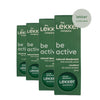01/08/2022
Wat doet Pepermuntolie voor je lichaam?
Je kent ze vast wel: de rood-witte pepermunt stokjes voor in de kerstboom. Je associeert het waarschijnlijk met Kerstmis! Naast dat pepermunt een kenmerkende traktatie is rond de feestdagen, wordt het ook gebruikt als een van de meest veelzijdige essentiële oliën. Het is een ingrediënt dat vaak wordt gebruikt in de wereld van homeopathie en huidverzorging, Vanwege de helende eigenschappen. Wat doet pepermuntolie voor je lichaam? Wij vertellen hier veel over in deze blog. Lees je mee?
Een stukje geschiedenis
Pepermunt maakt deel uit van de muntfamilie. Al eeuwenlang gebruiken mensen deze plant en de daarvan afgeleide olie om pijn te verlichten en ongemakken te verminderen. Wat doet Pepermuntolie voor je lichaam? Daar wisten ze al een lange tijd goed antwoord op te geven. Dit hebben studies later ook bevestigd. Pepermunt kan voordelen bieden bij mensen die last hebben van hoofdpijn, spijsverteringsproblemen en misselijkheid. Wij zijn daarbij fan van deze essentiële olie vanwege de frisse voordelen.
Pepermunt is onder andere bekend om zijn antibacteriële, ontstekingsremmende en antioxiderende eigenschappen. Onderzoek dat is gedaan op verschillende soorten bacteriën, suggereert dat pepermunt zelfs de groei van bepaalde soorten bacteriën kan stoppen. Toen wij dit hoorden, konden we niet anders dan concluderen wat een geweldig superhelden duo baking soda en pepermuntolie zijn om de perfecte natuurlijke deodorant mee te maken!
There is more! Voordelen van pepermuntolie
1. Vermindert jeuk en verlicht spierpijn
Pepermuntolie bevat menthol wat een verkoelend effect heeft en kan helpen tegen spierpijn en het verminderen van ontstekingen.
2. Houdt de pH-waarde in evenwicht
De ideale pH-waarde van je huid is tussen de 4,7 en 5,7. Omdat zweet heel alkalisch is, kan het je pH-waarden doen dalen. Bij correct gebruik kan pepermunt helpen bij het reguleren en balanceren van de huid.
3. Helpt bij de bloedcirculatie
Van de menthol in de etherische olie van pepermunt is ook aangetoond dat het de bloedsomloop en bloedstroom verbetert.
4. Houdt insecten weg
Hoewel wij juist dol zijn op de verfrissende en stimulerende geur van pepermunt, hebben insecten er een hekel aan!

Wat doet pepermunt olie voor je lichaam als je het niet goed gebruikt?
Pepermuntolie is, zoals veel etherische oliën, extreem geconcentreerd. Daarom raden we je altijd aan om voorzorgsmaatregelen te nemen bij het gebruik ervan. Wil je pepermuntolie in je huidverzorgingsroutine opnemen? Probeer dan 1-2 druppels te verdunnen met olie (zoals olijfolie of zoete amandelolie) en water.
Pepermuntolie is slechts voor uitwendig gebruik en less is more! Mensen met een gevoelige huid kunnen een reactie op pepermunt olie krijgen, dus test het altijd eerst op een klein stukje huid in je elleboog.
Pepermuntolie mag niet worden ingenomen. Als je op zoek bent naar een oplossing voor je spijsverteringsproblemen of misselijkheid, raadpleeg dan een homeopaat en zoek het juiste supplement op basis van pepermunt.
Pepermunt olie heeft heel veel voordelen als je het goed gebruikt. Probeer het eens uit met The Lekker Company Pepermunt & Rozemarijn deodorant.





























